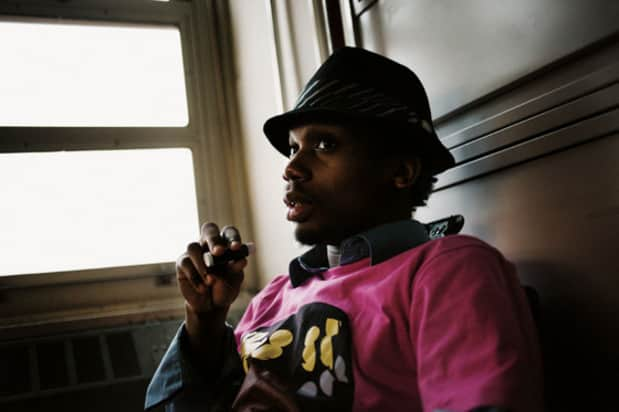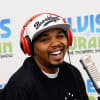For the covers of our newest NOW Issue, we chose two youngsters who've effortlessly mastered the art of internet self-promotion via prolific, enthralling DIY artistry. One of those covers, Charles Hamilton, released eight great mixtapes on eight different sites last year and frequently puts his taste for Sonic the Hedgehog on blast on charleshamilton.blogspot.com, but we still felt like we didn't know who he was. FADER editor Felipe Delerme went up to Harlem for a few days to shadow Hamilton at his home and high school and came back with a story not only about uptown's youngest, nerdiest star but the Harlem hustlers who will join his play for reign in 2009: Ron Browz, Jim Jones and Max B. Read the full story after the jump and keep checking TheFADER.com for Charles Hamilton exclusives.
“If Barack wins, I don’t wanna hear SHIT if he fucks up.” It’s a little after 5PM on Election Day in Harlem. Between drags of a Newport cigarette, Charles Hamilton is explaining his skepticism of the first national movement to move with. “Fuck anybody that’s not about the issues,” he continues. “You see this area? Does this look like middle class to you?” His voice begins to crack. “I’m coming from the perspective of somebody that made it out of this shit that still comes back here every day. I don’t wanna hear about change. Make it happen.”
We’re standing on Adam Clayton Powell Jr. Blvd. and 150th St., just outside the gates of Frederick Douglass Academy. It’s the last high school of five Hamilton attended before he dropped out and got his G.E.D., and the place where he still records the majority of his manically sincere music. This part of East Harlem resembles most of NYC’s working class neighborhoods, framed by bodegas dressed in dilapidated Arizona Iced Tea posters, generic fried chicken carry-out storefronts, a particularly dirty looking car wash and a poorly maintained city park. But while the landscape is not picturesque, people in Harlem tend to look continually ready to have their picture taken. Stroll across 125th St. and it’s struggle to rectify whether everyone dresses like Jim Jones, or if Jones dresses that way just because he's from Harlem. True Religion horseshoes adorn more back pockets than not, gaudy tattoo-inspired T-shirts are omnipresent and even counterfeit iced-out skull belts have to cost a little money. “Harlem knows how to front,” Hamilton explains. “I love it to death—but it’s not as economically beautiful as the people dress like it is.”
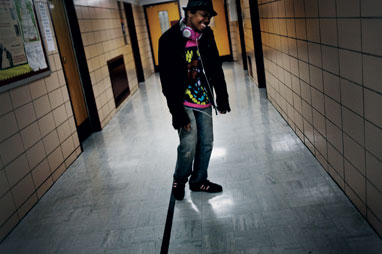
Hamilton’s own style is dictated by two very unique elements: the color pink—or the color of life, he says, since it’s the color of a woman’s womb—and a well-documented obsession with Sega Genesis’ videogame icon Sonic the Hedgehog. Today, the twenty-one-year-old is wearing a Sonic T-shirt over a pink button-down dress shirt, with a wallet chain at his side, studded wristbands and, coincidently, True Religion jeans. He tells me the jeans were a gift, and his hair looks like he hasn’t combed it in some time. While Hamilton’s look is very much his own, he isn’t above the influence of Harlem’s distinctive flamboyance. The difference is, it doesn’t define him. And yet today, Hamilton is at the forefront of a new era in Harlem rap history.
Not long ago, “Harlem World” belonged to Mase. In the mid-’90s, after the rapper linked with Bad Boy, he became the face of uptown, broadcasting the borough’s grandiosity while high-stepping across the "Feel So Good" video in an iridescent lounge suit. But in the summer of 1999, Violator Management released a compilation showcasing its then-strapping client roster, appropriately titled Violator: The Album. Tucked deep into its twenty tracks is Cam’ron’s “What My Niggas Want,” on which he raps: Y’all acting a little/ Why y’all rapping in riddles?/ Got Harlem looking like we a pack of Skittles. This particular shot was fired directly at Mase, his former friend and fellow crew member in Children of the Corn, and marked a distinct changing of the tide. Cam’s new crew, the Diplomats, clad in helmet sized New Era fitteds and equally enormous leather Jeff Hamilton jackets, were next in line to define Harlem swagger. Jim Jones and Juelz Santana were groomed under the same familial Dipset umbrella, and they ruled the area in the early ’00s. As Cam’ron’s cohorts, the group had a much grimier glow than Mase’s disarmingly bright smile. “We showed what Harlem was really about, what it stood for at that time,” says Jones, Harlem’s de facto ruler. “We was young and we was always one foot in and one foot out. We always said stay close to the streets and shit like that and that’s what we really reflected, from the way we dressed to the things we talked about.”
Jones is a perfect counterpart to Hamilton, and continues to dominate their shared home with his fourth and most accessible album yet, Prey IV Reign. Jones and Hamilton are already scheduled to work together, and at this point in his career, Jones is a great friend to have. He was a key player in the ascendance of Max B. Calling himself Bigavelli (for Biggie, Jigga and Makavelli), he came to Jones seemingly from the heavens, or more accurately from some hells, fresh off serving eight and one year jail terms, one after the other. B’s impact was immediate: he carried the phenomenal MOB: Members of Byrd Gang mixtape, breathed life into Jones hits like “G’s Up” and “Baby Girl,” and even authored the chorus for Jones’ biggest hit to date, “We Fly High.”
Now another contender for Harlem’s throne, Max B has since taken a page from the book of his former friend and current rival Jones—selling his swag, a lifestyle he’s termed “wavy,” alongside his nasally melodic mixtape material that has flooded the streets. His style is equal parts singing and rapping, probably best described by B himself as “riding the wave.” He leans dizzily on and off beat on tracks like “Disturbia Money” (a take on Rihanna’s “Disturbia”) or the appropriated melody of Blondie’s “Heart of Glass” for his own “Tattoos on Her Ass,” produced by frequent collaborator and fellow Harlem native Dame Grease. And though Max B and Charles Hamilton represent two very different sects within Harlem music, as a team they’re complimentary, rapping together on “The North Pole,” their voices connected by the same undeniable Harlem hubris.
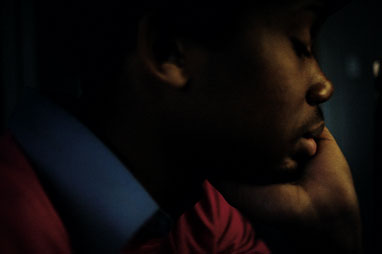
Hamilton is naturally talkative, but doesn't prattle; everything he says builds to a point he’s trying to make. His raps, on the other hand, can be far less formulaic. Hamilton is the king of improvised thought-streams and jubilant non sequiturs, rambling about Sega Genesis (constantly), his frustration with relationships (frequently) and how good a rapper he is (occasionally). “I don’t know how to read music, but I know how to sound music. So like, if I’m on beat, but not flowing, then I’m definitely easing in and out of the beat. I call it time mathematics, to be able to know how many words you can fit at a certain speed before your time is up,” he says. He paints himself as a contemplative but wisecracking everyman, navigating his young life’s already tumultuous course. "It’s hard when you ain’t got nothing, you dig, but [Hamilton] didn’t choose to sell crack and hustle and grab the gun,” says Jim Jones. “He did it a different way and got the same point across.”
Walking the halls of Frederick Douglass Academy this Tuesday evening, Hamilton greets the few students he passes on their way to extracurricular obligations. At one point the school principle stops him to ask if he has a stopwatch. The people we encounter come off as an extended family of sorts, which makes sense: when Hamilton left his mother’s house during the tail end of his high school career, the couch in the school’s recording studio was one of the places he slept.
Since September of this year, Hamilton has ricocheted between Frederick Douglass and a home studio upstate, pumping out six of a scheduled eight separately themed mixtapes of original music called The Hamiltonization Process, each of which he debuts on a different hip-hop blog. “My main focus is free music, and the reason why is water isn’t free. What’s more natural than water? Music,” he says. Then there are Crash Landed and Outside Looking, two mixtapes full of Hamilton’s quirky samples and conversational rap style. He programs music from Sonic the Hedgehog video games and mines tragic pop culture nostalgia, laying them out like worn mattresses for his own back-alley, stream of consciousness gymnastics. On “Stutter,” he raps over a looped bridge of Vince Guaraldi’s “Linus and Lucy,” singing, P-P-People always sayin, Charles you can’t sell/ Lyrically, you are a nuisance, but you can’t tell/ And I wanna beat they ass till my two hands swell/ Yea hit em up style, like Blu Cantrell. On “Rockstar Girl,” he sings along to The Offspring’s “Self-Esteem,” barely looping the opening riff while he airs out the lameness of star-crossed love. When Hamilton raps, there’s a closely manicured arrogance. It’s like he’s doing you a favor by letting you hear what goes on in his brain. On the songs where he sings, his voice drags kind of hopelessly like a detached Kurt Cobain, minus the range. “All the emotions that I put in the music that you might not hear in my voice, you have to find in the words. And sometimes you can hear it in the voice, I can’t fight it,” he says.
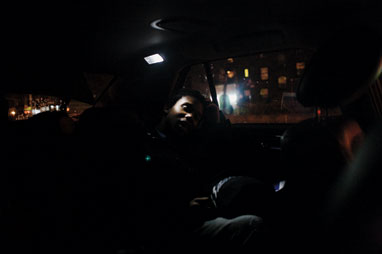
Hamilton doesn’t have to flaunt typical NYC entitlement or act intimidating, a trait he shares with Harlem’s old guard. “Most people enter hip-hop to make more money,” he says. “I entered hip-hop to make better music.” Granted, the wiry Hamilton isn’t intimidating anyone physically, but the borough’s ills are certainly renowned enough for him to ride with them, and it’s isolated enough in terms of NYC territories for him to get away with it. But even in the case of rappers like Cam’ron (once known as KFC, or Killa Fucking Cam’ron), in rhyme, Harlem always seemed more interested in extolling the fruits of its labor, as opposed detailing the actual labor itself. From “Oh Boy”—the track where Cam probably wished his catalog began—to Jim Jones’ “We Fly High,” Harlem rap in the national scope has been defined by look-what-I-got-but-don’t-ask-how-I-got-it, pinkie ring lapel-stroking.
A recent example of this is Harlem-bred producer Ron Browz’ summer smash, “Pop Champagne,” an Auto-Tuned VIP hymn celebrating the nectar of the gods and godbodies. Although he’s since sold the song to Jim Jones, Browz recently signed to Universal and is currently finishing up his own debut. And in Browz’s music, another Harlem influence may have actually come full circle. “I’m a new face, a new sound, new everything,” Browz says. “Kinda like when Mase came out.”
Hamilton loved Mase. He admits that he isn’t a big fan of Browz's “Pop Champagne,” but that the merit within it is not lost on him. While he’s technically still young enough to do dances with names without looking silly, he doesn’t Get Lite or Harlem Shake or attempt any of the other dances Harlem youth are enthralled with right now. What he does do is make a remarkable amount of music at a staggering pace. So much so that he’s once again sleeping in the studio. It’s just that now it’s the one located in his home, as opposed to the one he once had to make a home out of. Considering the instability he’s bested, I can’t help but ask if this work ethic is a means to an end. Quickly, he corrects me. “It’s a means to a beginning,” he says.
